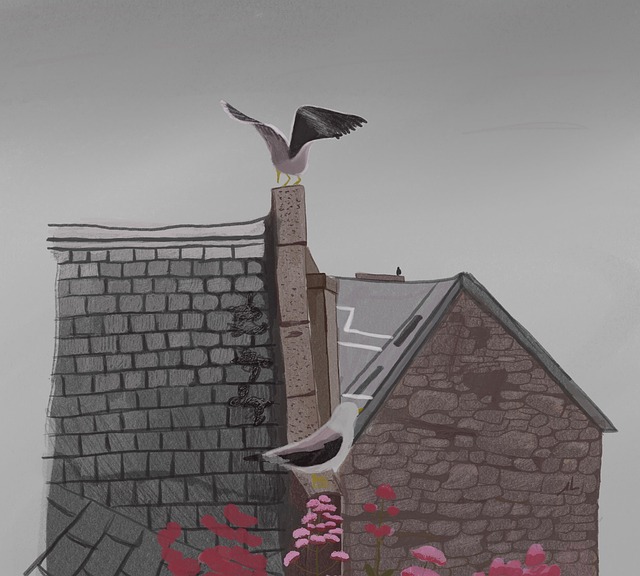Green roofing systems offer a sustainable and cost-effective solution for enhancing indoor air quality and comfort in urban areas. By using natural wind forces for cooling, these systems reduce energy consumption compared to artificial cooling methods. The vegetation on green roofs acts as an insulator, regulating temperatures year-round. Proper design, considering roof orientation, climate, and wind patterns, maximizes airflow and further improves indoor air quality. Real-world case studies demonstrate significant benefits in office buildings and residential complexes, leading to cost savings and improved living conditions. The future of natural ventilation focuses on integrating green roofing systems with smart building technologies for enhanced energy efficiency and ecological sustainability.
In today’s quest for energy-efficient buildings, integrating natural ventilation features offers a compelling solution. This article explores how understanding natural ventilation and its benefits can revolutionize indoor air quality and overall building efficiency. We delve into the role of green roofing systems as powerful tools to enhance airflow, along with key design considerations for optimal aeration. Real-world case studies highlight successful integrations, while looking ahead at future trends in natural ventilation technology, including innovations driven by sustainability.
Understanding Natural Ventilation and Its Benefits
Natural ventilation is a sustainable and cost-effective way to improve indoor air quality and comfort, especially in urban areas where proper airflow can be challenging. This process leverages external wind forces to create a flow of air, cooling down spaces without relying on mechanical systems. By integrating natural ventilation strategies into buildings, such as green roofing systems, architects and designers can enhance energy efficiency while promoting healthier living environments.
One of the key advantages is its ability to reduce the need for artificial cooling, thereby lowering energy consumption and associated costs. Green roofs, with their vegetation and soil layers, act as a natural buffer against extreme temperatures. During warmer months, the plants absorb heat and provide insulation, keeping buildings cooler. Conversely, in colder seasons, the plant material helps insulate the structure, preventing heat loss. This dynamic creates a more comfortable indoor climate year-round, making it an environmentally friendly solution for modern architecture.
The Role of Green Roofing Systems in Enhancing Airflow
Green roofing systems play a pivotal role in enhancing airflow and overall building efficiency. These innovative systems involve planting and growing vegetation on rooftops, offering multiple environmental benefits. Beyond aesthetics, green roofs act as natural insulators, mitigating extreme temperatures by absorbing heat during warmer months and providing insulation during colder periods. This temperature regulation not only reduces the need for artificial cooling or heating but also improves indoor air quality by filtering pollutants and releasing oxygen.
The vegetation in these systems serves as a natural filter, trapping particulate matter and other airborne contaminants. Moreover, the root structures of plants create tiny channels that draw in fresh air and expel warmer air, facilitating passive ventilation. This natural process complements mechanical HVAC systems, reducing energy consumption and providing a healthier indoor environment.
Designing for Optimal Aeration: Key Considerations
Designing for optimal aeration involves a strategic approach that integrates both architectural design and natural elements, such as green roofing systems. These systems, composed of living vegetation grown on rooftops, offer multiple advantages. They not only enhance aesthetic appeal but also provide insulation, reducing energy consumption. The careful placement of these systems can maximize airflow, leveraging the natural movement of air to create a comfortable indoor environment without excessive mechanical ventilation.
Key considerations include orientation and slope of the roof, local climate patterns, and wind direction. Architects should design spaces that capture breezes during cooler months while minimizing direct sunlight to prevent overheating in warmer seasons. Incorporating overhangs, canopy structures, or trellises can further optimize air circulation by blocking intense solar radiation while allowing for natural ventilation. By thoughtfully integrating green roofing systems and other aeration strategies, buildings can achieve better indoor air quality, reduced energy costs, and a more sustainable design.
Case Studies: Successful Integrations in Real-World Projects
Many successful case studies demonstrate the effectiveness of integrating natural ventilation features in real-world projects. For instance, several modern office buildings have incorporated green roofing systems alongside strategic window placements and openable walls to create harmonious indoor-outdoor connections. These designs not only enhance employee well-being but also significantly reduce energy consumption for cooling, resulting in substantial cost savings.
Another notable example involves residential complexes that utilize natural cross-ventilation through carefully planned building orientation and operable windows. This approach has led to improved air quality, reduced noise pollution, and more comfortable living spaces. These case studies highlight the potential of integrating sustainable design principles, such as green roofing systems, to achieve both environmental and economic benefits.
Future Trends and Innovations in Natural Ventilation Technology
The future of natural ventilation technology is brimming with innovative possibilities, driven by a growing focus on sustainability and energy efficiency. One promising trend is the integration of green roofing systems, which not only enhance biodiversity but also act as natural insulators, reducing the need for artificial cooling. These roofs are designed to mimic natural ecosystems, featuring plants that absorb heat, improve air quality, and create microclimates, thereby optimizing ventilation effects.
Additionally, smart building technologies are playing a pivotal role in advancing natural ventilation systems. Sensor-driven algorithms can now accurately monitor indoor environments, allowing for precise control of openings and vents. This ensures optimal airflow while minimizing energy losses, making buildings more efficient and environmentally friendly. As technology continues to evolve, we can expect even more sophisticated solutions that revolutionize how we harness natural ventilation for better comfort and reduced ecological footprints.
Integrating natural ventilation features, such as green roofing systems, offers a sustainable and efficient solution for enhancing airflow within buildings. As demonstrated by successful case studies, thoughtful design considerations can optimize aeration, leading to more comfortable indoor environments and reduced energy consumption. With ongoing innovations in natural ventilation technology, the future looks bright for improving the way we breathe and live in our built spaces.
